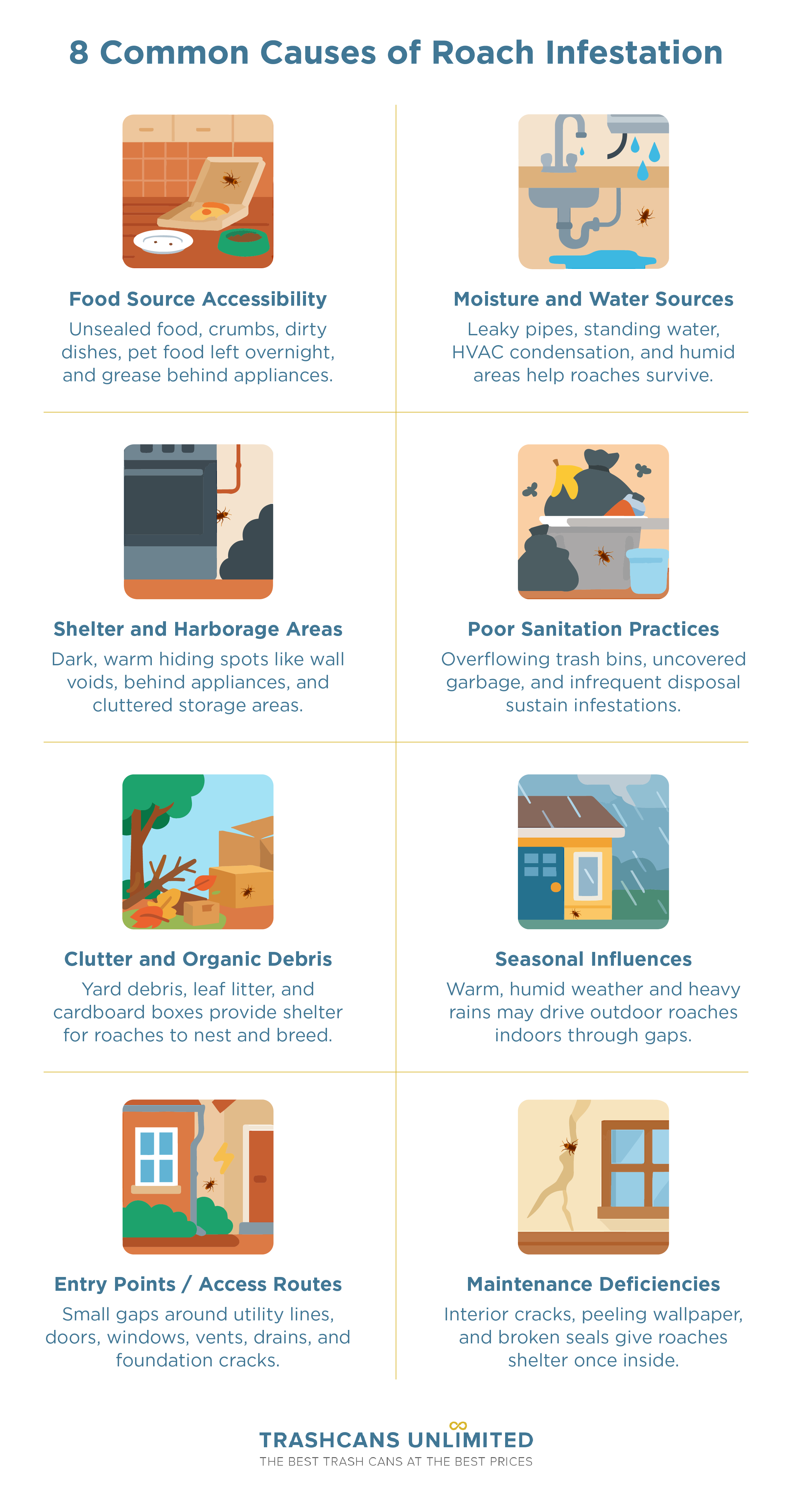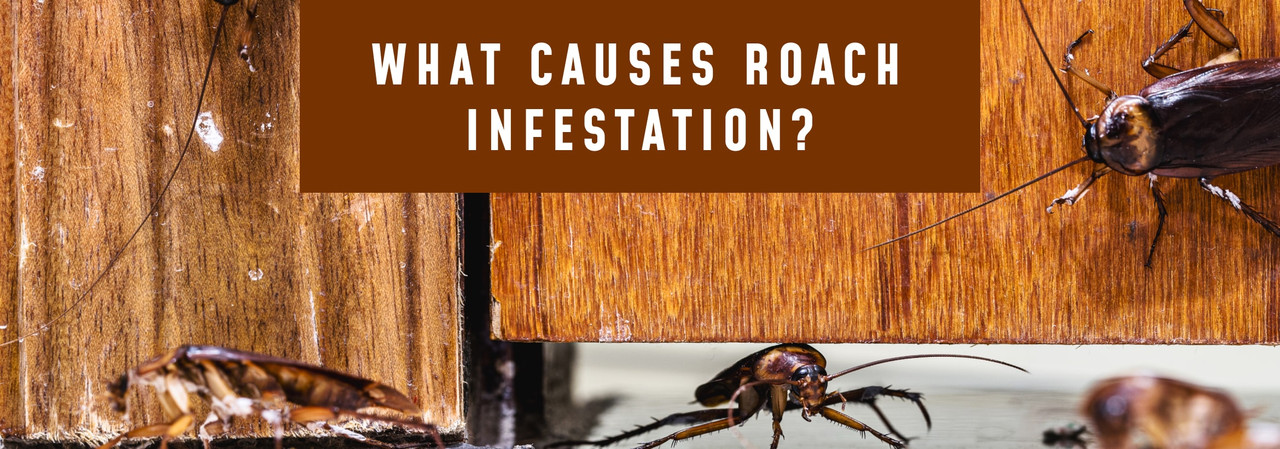You slam your crumbs-laden counter, heart racing, as a spindly leg scuttles across the edge of your sink—an instant jolt of revulsion and panic. What causes roach infestation? Roach infestations explode when these stealthy intruders discover the perfect cocktail: easy food, hidden moisture, and dark, undisturbed shelter. Once inside, they breed by the dozens, laying capsule-like oothecae in crevices you can’t see, and before long, you’re facing a full-blown invasion.
Key Takeaways
- Roaches move in when they find food, water, and secluded hiding areas.
- The sooner you identify what causes roach infestation, the easier it is to intervene.
- You can manage infestations effectively with safe, low-risk control methods.

Environmental Factors That Attract Cockroaches
Cockroaches aren’t arbitrary houseguests—they zero in on clues that promise food, water, and shelter. By learning how each factor lures them in, you can cut off their access and starve them out. Understanding what attracts cockroaches is key to staying one step ahead.
Food Sources And Accessibility
Cockroaches are omnivores that scavenge whatever you leave within reach. Whether it’s leftover pizza crust under the coffee table, a smear of syrup behind the toaster, or a few scattered cereal flakes in the pantry, they’ll find it. Cockroaches prefer to nest within a few feet of their food sources, often lurking behind refrigerators or beneath cabinets.
- Pet food bowls left out after dark. Even a small stash of kibble provides a reliable buffet.
- Grease buildup in crevices. Unseen oil splatters behind the stove or under the oven vent can sustain roaches long after the meal is gone.
- Open trash and recycling bins. Each unsealed bag or lid turns your kitchen into a five‐star restaurant for cockroaches. You drastically reduce their food access by switching to a heavy‐duty trash can with a tight‐fitting lid.
Moisture And Water Sources
Another factor in what causes roach infestation is water. Water sustains roach colonies. Without it, they perish within days. Leaky pipes and dripping faucets act as beacons, guiding roaches to your home’s hidden reservoirs. Even seemingly minor sources—such as condensation under an A/C unit, a damp pan beneath the refrigerator, or a puddle in an unused drain pan—offer enough hydration to keep them alive. Oriental and American cockroaches often congregate near outdoor drains and pooling rainwater before venturing inside through cracks.
- Leaky sink: A persistent drip creates a micro‐oasis. Fix it immediately.
- Humidity in basements or crawl spaces: Install a dehumidifier and seal foundation cracks to eliminate condensation spots.
- Pet bowls and unattended potted plant trays: Empty water dishes at night and avoid overwatering indoor plants to remove tempting moisture sources.
Shelter And Harborage Areas
Dark, warm, undisturbed spaces are another answer to what causes roach infestation. Cockroaches seek darkness, warmth, and seclusion. They exploit any crack, crevice, or cluttered hideaway. Common indoor shelters include wall voids, cabinetry voids, and small spaces behind kitchen appliances. Cardboard boxes, stacks of newspapers, and paper bags provide both shelter and subtle moisture retention, making them roach‐approved nurseries.
- Cardboard and paper clutter: Replace long‐term storage with plastic bins.
- Space behind appliances: Keep gaps minimal by sealing edges with caulk, or pull appliances away from walls when practical to inspect periodically.
- Heated storage areas: Spaces near water heaters, furnaces, or heated basements maintain temperatures that roaches favor—keep these areas well‐lit, clean, and sealed.
Entry Points And Access Routes
Understanding what causes roach infestation also means sealing their entry points. Roaches can squeeze through openings as small as 1/16 of an inch—enough to slip under worn door sweeps, through gaps around plumbing, or into vents without screens. Certain cockroaches often infiltrate new homes inside cardboard boxes or secondhand electronics. Once inside, they traverse wall voids and ducts, journeying from room to room.
- Cracks around plumbing penetrations: Seal with silicone caulk or steel wool filler.
- Damaged weatherstripping under exterior doors: Replace or adjust to close gaps.
- Unscreened vents and ducts: Install fine mesh screens to barricade cockroach highways.
Human Behaviors And Home Maintenance Issues
Another major contributor to what causes roach infestation is human behavior. Your daily choices and upkeep routines (or lapses) deter or invite roaches. Adjusting simple habits and addressing maintenance gaps can fortify your home against infestation. Applying practical cockroach control tips will make a huge difference.
Sanitation Practices
Poor cleaning habits are one of the top reasons behind what causes roach infestation. They can survive on microscopic food bits—crumbs that slip under your rugs or behind appliances stay on their radar long after you think “clean” has done its job.
- Store pantry items in sealed, airtight containers: Glass or sturdy plastic bins keep crumbs out of reach.
- Wipe counters, sweep floors, and mop spills immediately: Especially behind and beneath stoves, refrigerators, and dishwashers where food debris accumulates unseen.
- Empty trash regularly and use heavy‐duty liners: Opt for a trash can with a tight‐fitting lid from Trashcans Unlimited to keep odors and odors only—it also keeps roaches out.
- Clean pet dishes and don’t leave food bowls out overnight: Even a few kibble pieces deliver a meal to hungry roaches in your home.
Structural And Maintenance Deficiencies
Small structural flaws or deferred home repairs create roach‐friendly pathways and hideouts.
- Unsealed cracks in walls, foundations, or around utility penetrations: Use high‐grade silicone caulk or expanding foam to barricade gaps.
- Loose or torn window screens: Replace immediately; even a pinhole gives roaches and other pests access.
- Warped or missing weatherstripping: Check exterior doors and windows monthly; replace weatherstripping to maintain a tight seal.
- Dripping faucets and minor leaks: Every drop counts—inspect plumbing under sinks and around toilets, patching leaks within 24 hours.
Recognizing what attracts cockroaches helps you prioritize repairs that will keep them out.
Seasonal And Environmental Influences
Roach activity spikes when external conditions push them indoors:
- Warm, humid months (spring through early fall) boost breeding cycles. German cockroaches can produce up to six generations per year under ideal conditions.
- Heavy rain and flooding may drive outdoor species (American and Oriental cockroaches) inside seeking drier ground.
- Drought periods create competition for moisture; roaches follow plumbing leaks and condensation into homes.
By anticipating seasonal surges—ensuring screens are tight and gutters divert water away from your foundation—you close roaches’ routes of ingress before they emerge. Preparing ahead of seasonal surges with cockroach control tips, like tightening screens and improving drainage, can significantly reduce the risk.
Signs Of Established Infestations
Catching roaches early gives you the upper hand. By the time you see a live roach scurry across the floor, hundreds may already be hiding out of sight. Watch for these telltale markers:
- Pepper‐like droppings: Tiny droppings—dark, cylindrical pellets—accumulate along baseboards, behind appliances, and in cabinet corners.
- Oothecae (egg cases): Brown, capsule‐shaped pods often appear tucked into cracks, behind furniture, or inside cabinets. Finding one means reproduction is underway.
- Greasy smear marks on walls and floors: Roaches leave oily trails as they travel along their routes.
- Musty or oily odor: A strong, lingering smell in closed spaces (pantries, attics, basements) signals high roach populations.
- Shed skins and dark specks: Roaches molt multiple times; skin casings in hidden nooks indicate active breeding.
- Sticky trap catches: Placing sticky traps near suspected hotspots (behind the fridge, under sinks) helps you gauge infestation size.
Inspect warm, damp, and cluttered spaces—especially under sinks, behind appliances, and near water heaters—at least monthly. If you see multiple signposts (droppings, oothecae, or smear marks), it’s time to implement a targeted control plan. Knowing what causes roach infestation can help you detect and address issues faster.
Integrating Safe, Effective Control Methods
Eliminating established roach colonies requires understanding what causes roach infestation and a coordinated approach that combines sanitation, exclusion, monitoring, and targeted treatments. Rather than relying solely on sprays (which can trigger allergies and push roaches deeper into hiding), follow these pest management principles and expert cockroach control tips:
Sanitation First
- Remove all accessible food, moisture, and hiding spots (the “survival triangle”).
- Use soapy water or enzyme‐based cleaners to scrub surfaces; dry thoroughly.
- Dispose of clutter—especially cardboard, stacks of newspaper, and unused paper products.
- Replace disposable boxes with sealed plastic bins.
Exclude and Seal
- Caulk cracks around pipes, baseboards, and doors.
- Repair or replace damaged screens, weatherstripping, and door sweeps.
- Install fine mesh on vents, ducts, and floor drains.
- Store bags, boxes, and furniture in sealed areas until you confirm they’re roach‐free.
Monitor With Sticky Traps
- Place trap monitors in high‐risk areas (kitchens, bathrooms, attics).
- Label and date each trap to track roach activity over time.
- Use trap counts to identify hotspots and direct treatment efforts precisely.
Targeted Baits and IGRs (Insect Growth Regulators)
- Baits containing slow‐acting toxins let roaches carry poison back to the nest.
- IGRs prevent nymphs from maturing; they break the reproductive cycle.
- Always place baits in cracks and crevices—never on countertops or in areas accessible to children and pets.
Vacuum and Clean
- Use a HEPA‐filtered vacuum to remove live roaches, eggs, and debris before applying treatments.
- Empty vacuum contents into a sealed bag and remove it from your home immediately.
Professional Consultation When Needed
- If you continue to find large numbers of roaches despite implementing IPM, enlist a licensed pest control professional familiar with cockroach biology and IPM methods.
- Share your monitoring data—trap counts and placement maps—to help them evaluate hotspots.
Lock Out Roaches with Unbreakable Stewardship
You’ve learned what causes roach infestation and what attracts cockroaches. Denying roaches food and moisture shrinks their chances of survival. Now, amplify your defense: upgrade to a heavy‐duty trash can with an airtight lid from Trashcans Unlimited. Our precision‐fit trash cans keep foul odors sealed and roaches perched outside, hungry but shut out. Reinforce your kitchen’s frontline—fortify your waste management, and watch roaches move on to less prepared homes. Get a quote and protect your family and peace of mind today.

